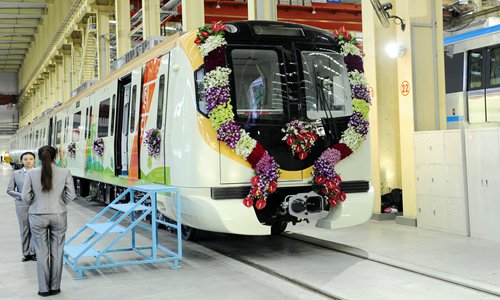
A China-made subway is ready to be exported to Nagpur, India in November 2018. (Photo: IC)
India's refusal to cooperate under the China-proposed Belt and Road Initiative (BRI) will make it lose many growth opportunities and harm its connectivity with other countries in South Asia, experts said Monday.
India turned down an official invitation from China to attend the second Belt and Road Forum, which will take place later in April in Beijing, The Times of India reported on Monday, citing diplomatic sources.
"China's invitation to India to join the forum... takes into account India's development needs," Lou Chunhao, deputy director of Institute of South Asian Studies at the China Institutes of Contemporary International Relations, told the Global Times on Monday.
The promotion of the BRI in South Asia will help advance regional connectivity in terms of capital, technology and people, which is not only conducive to China's development, but will also drive other countries including India. "The initiative will help India strengthen ties with other countries in the region," Lou said.
South Asia is one of the significant regions to advance the BRI, as can be seen in some pilot projects that have been smoothly conducted.
Gwadar, a small fishing town located in southwestern Pakistan, has achieved several development milestones, including port transport, a business center and a free zone, under the China-Pakistan Economic Corridor (CPEC), which has been advanced over the past five years.
Chinese Foreign Ministry Spokesperson Geng Shuang said in September 2018 that the corridor construction is open to third-party participation to benefit the entire region.
Experts said that the BRI is entering a new phase with more and more third-party participation, and the initiative will further expand to global markets such as Africa and Europe, and promote the development of the surrounding areas of the Indian Ocean.
Italy and Luxembourg recently signed memoranda of understanding (MOU) on the BRI with China, bringing the number of similar documents to 22 in Europe.
"If India insists on turning its back on cooperation under the BRI or even interferes with certain projects, it will miss many development opportunities and its links with other South Asian countries would be harmed," Lou said.
Infrastructure construction under the BRI also saw stable growth in many South Asian countries.
For example, China helped Sri Lanka build a 96-kilometer southern expressway in 2013, which links the capital Colombo with the southern city of Galle. Apart from the transport sector, the two countries have expanded cooperation into other industries, aiming to transform Sri Lanka into a maritime center in the Indian Ocean region, the Xinhua News Agency reported.
China and Bangladesh, which formally joined the BRI in 2016, are engaged in developing projects under the initiative and construction work on the Karnaphuli Tunnel in southern Bangladesh is now in progress.
China and Nepal signed an MOU on the BRI in May 2017 to enhance connectivity in ports, roads, railways, aviation and communications.
Remaining issues
India's trade deficit with China is the most important issue in their bilateral economic and trade relationship, said Atul Dalakoti, executive director for China of the Federation of Indian Chambers of Commerce and Industry.
The Indian government has submitted a list of 380 items including agricultural and horticultural products, pharmaceutical products, chemicals, textiles and tobacco for increasing exports from India, said Dalakoti.
China-India trade rose 13.2 percent year-on-year to $95.54 billion in 2018, with China's exports to India worth $76.71 billion, up 12.7 percent on a yearly basis and imports from India reaching $18.83 billion, up 15.2 percent year-on-year, according to the Chinese Ministry of Commerce.
An imbalance persists, however, in China-India trade. India is seeking greater Chinese market access for agricultural products and also wants to strengthen people-to-people exchanges with China, exporting software services, which is a sector India has an advantage in, Liu Xiaoxue, an associate research fellow at the Chinese Academy of Social Sciences, told the Global Times on Monday.
Differences in trade structures also worry India, which thinks its exports are low-end goods such as iron ore and agricultural products while Chinese exports are electrical products, Lou noted.
Strategic economic talks between the two countries are expected to be held to address such trade and economic issues, experts said.
Indian companies are being encouraged to attend the second China International Import Expo in Shanghai in November and try to develop awareness of Indian products among Chinese companies and consumers, Dalakoti noted.
India could also attract more Chinese investment, for instance, in the manufacturing sector, which will help enhance its industrialization and facilitate its exports, not only to China but to other countries, Lou said.
Chinese home appliance maker Qingdao Haier Co recently held the groundbreaking ceremony for its second industrial park in Greater Noida in India's northern state of Uttar Pradesh, the Xinhua News Agency reported on Sunday. The park will create about 14,000 jobs for local people.


